Eliza Knight's Blog, page 58
March 22, 2012
FORT SUMTER-Then & Now By Nancy Lee Badger
Today on History Undressed, I'd like to welcome back, Nancy Lee Badger! She's written a great post for us today on Fort Sumter. And I must say, I love the title of her new book!
FORT SUMTER-Then& NowBy Nancy LeeBadger author of SOUTHERN FRIED DRAGON
A funny thinghappened one year ago this month while celebrating my husband's birthday. Wetook a few days off and headed south to Charleston, South Carolina. The harboris famous for the various forts and battle scenes made infamous during The War Between The States, also knownon its 150th anniversary as TheCivil War. As history buffs, and as descendants of those who fought in thewar, we wanted to see where it all began. Little did I know that the experiencewould culminate in SOUTHERN FRIED DRAGON,my latest paranormal romance.
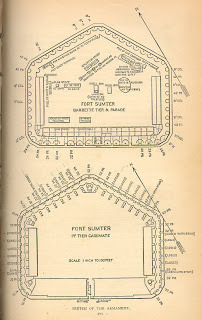 Fort Sumter -- THENWe toured thefirst of two museums to get a flavor for what the ferry ride would offer later.We saw grainy black & white photos, and drawings depicting life in the cityof Charleston before talk of secession made its way to its halls. The city is nestledin a protective harbor made safe by the many forts lining the waterway. Begunin 1829 while memories of the war of independence from the British were stillfresh, the fort was still not nearly complete when the threat of secessiongrew. The Federal government's huge five-sided fort on a man-made island ofstone was built to protect against possible seafaring attacks from foreigngovernments or pirates. No one would have foreseen its explosive demise.
Fort Sumter -- THENWe toured thefirst of two museums to get a flavor for what the ferry ride would offer later.We saw grainy black & white photos, and drawings depicting life in the cityof Charleston before talk of secession made its way to its halls. The city is nestledin a protective harbor made safe by the many forts lining the waterway. Begunin 1829 while memories of the war of independence from the British were stillfresh, the fort was still not nearly complete when the threat of secessiongrew. The Federal government's huge five-sided fort on a man-made island ofstone was built to protect against possible seafaring attacks from foreigngovernments or pirates. No one would have foreseen its explosive demise.My book's hero,a federal officer of Scottish descent, is stationed at Fort Moultrie when wordcomes that a special secession convention had voted unanimously to secede fromthe union. I describe how under the cover of darkness he and his men secretlytransferred from indefensible Fort Moultrie and took over the partially builtFort Sumter. In theory, Fort Sumter was a well thought out construction project.Three stories of thick brick and stone, it was immense for the times. However,it was built to withstand bombardments from passing ships, whose low-slung cannonscould not breach the inner sanctum.
Unfortunately,the southern secession forces took over several batteries that stood on landless than a mile away. Their shells easily flew up and over the walls, landinginside the fort where they did horrific damage. Luckily, no lives were lost,but return fire was sparse. The Federal soldiers were small in number and mostcannons faced the open sea. They had no fuses to explode the cannon balls and theirfood was nearly gone. Surrender came within thirty-four hours of the firstshell.
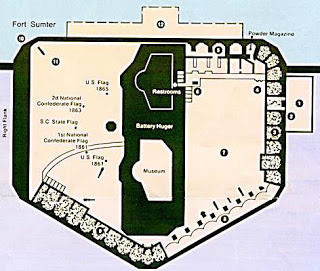 Fort Sumter National MonumentThe boat rideout into the harbor was pleasant. When we walked along the wharf and stared atwhat was left of the walls, we were silenced by what we saw. Even though littleis left of the original structure, our visit allowed us to walk through theSally Port and into the inner parade ground. Dozens of cannons were on displaysurrounded by battered walls, broken staircases, and decrepit barracks.
Fort Sumter National MonumentThe boat rideout into the harbor was pleasant. When we walked along the wharf and stared atwhat was left of the walls, we were silenced by what we saw. Even though littleis left of the original structure, our visit allowed us to walk through theSally Port and into the inner parade ground. Dozens of cannons were on displaysurrounded by battered walls, broken staircases, and decrepit barracks. The sectioncalled Battery Huger, added years later, contains another museum and a tatteredflag that once flew above the fort. A grassy overlook allows visitors to looktoward the sea and imagine the soldiers as they waited for supply ships that neverarrived. The fort's five-foot-thick walls still stand, but only the firstfloor. Parts of the second level are in ruin, but the entire third level wasblown away as the war progressed and after the Confederates took control of thegrounds. There is little left of the enlisted men's barracks, or the officer's quarters.Though the fort was 90% complete by the time the Federal soldiers were firedupon and held ports for 135 guns and could house a garrison of 650 men, only aboutnine or ten casement guns returned fire. Only 85 men stood against thousandsduring April 12 through April 14th, the beginning of what becamefour years of Civil War.
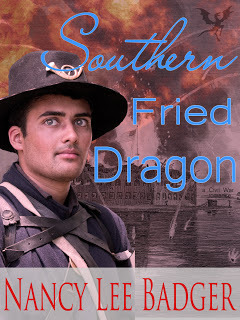 BOOK BLURB
BOOK BLURBAmidcannon fire, and the threat of Civil War, love and trust will find a way.
DruLittle flew away from her home in a cave beneath a Scottish Island to end herlonely existence and find companionship across the sea. Her journey in late1860 has led her to the modern American city of Charleston, South Carolina.Hiding her true self, she takes over the life of a serving girl and enjoys thehard life working in a tavern near the wharves. She has no idea that her lifewill turn upside down in a dark alley the moment a handsome soldier saves herlife.
LieutenantShaw Stenhouse has his own worries. Southern secessionists are talking up astorm in Charleston. His fellow Federal soldiers are suddenly at risk from thecommunity they are here to protect. The possibility of civil war takes abackseat when he saves a comely lass from drunken sailors. A good deed and astolen kiss put a smile on his face until the threat of war becomes a reality.Their instant attraction proves disastrous when Dru spots her former lover, theBlack Dragon, working for General Beauregard and the southern troops. As theclandestine group plans their attack on Fort Sumter, and Shaw's soldiers, shetakes to the sky.
Drufights against the threat of detection, while she fears losing Shaw's love.What will he do when he finds out that she is a powerful Scottish dragonHell-bent on carrying him to safety? When Shaw discovers her hiding inside theheavily guarded fortress, thoughts of espionage—and worse—catapult the twolovers into danger from many sides.
Whenher former lover threatens Shaw, Dru must decide which is more important:protecting another of her kind, now nearly extinct, or protecting the humanmale, the man she has come to love.
EXCERPT
Dru wanted to take flight and find Shaw.Was he all right? Where could he and his fellow soldiers have gone? Would sheever see him again?She missed his kisses, but wanted him tostay safe. Her heartbeat pounded in her human chest when she dreamed of him.Her body softened when she remembered his taste, his smell, and the feel of hisnaked chest as he rose over her. Why had Mistress Cumberland interruptedthem? Her body had made ready for his, welcoming him. Frustration filled hernights since he kissed her cheek and returned to Sullivan Island.Now? He'd left Fort Moultrie for placesunknown.Maggie muttered something.Dru refilled the pitchers, then tossedpieces of Maggie's fried chicken on a platter. The aroma made Dru's stomachgrowl. "Maggie, speak up. I cannot offer my opinion if I do not know thequestion.""I am complaining, that be all. I wouldrather be abed. My head aches and I feel the cold, today."Dru smiled. The weather had turnedblustery, but warmer than the winters she spent in Scotland. "Why not take toyer bed? I can handle the few men who have not the sense to keep to their homesthis day.""Ah, you are a lovely lass. What wouldMistress Cumberland say?""She's off to church then to herdaughter's home for dinner."Maggie removed a large tray of biscuitsfrom the oven, then wiped her hands on her apron. She sighed as she kissed Druon the cheek, then trudged up the back stairs. The peck on the cheek, sosimilar to Shaw's kiss, did not ignite her senses the way they sparked to lifewhen Shaw drew near. Dru hefted the pitcher of cider,foregoing the ale. Men had no need to get in their cups tonight. Cradling abasket filled with Maggie's biscuits, she pushed through the door separatingthe hot kitchen from the much cooler dining hall. As she walked among the tables, a half adozen men nodded. She filled their tankards and offered biscuits. Her heightened dragon hearing caught theirconversation. The tone sounded tinged with anger, while some chuckled."Aye, they turned tail and ran," one mansaid."The fort is burning. Nobody's home, Ihear.""Are you talking 'bout the soldiers fromFort Moultrie?" Dru asked, biting her bottom lip for her impertinence."We are, woman. The soldier boys arecowards." Laughter filled the dining hall.Dru forced a smile, though inside sheworried about Shaw. The fort was aflame? Where was he? "Where have they gone, do ye suppose?"she asked, pouring more cider to delay her return to the kitchen. She wouldrather take flight, follow Shaw's scent, and carry him to safety. Maybe, allthe way back to Scotland."I have no idea," one man said, beforedowning his cider."I know."All heads turned toward a spry oldfisherman who had settled by the front window. Dru recognized him as the kindman who'd delivered Shaw's gift. He sat alone with a cup of tea."What do you know, Joseph?" A largedockworker stood and tossed the man a hot biscuit. Joseph caught it on the flywithout moving more than one arm."I've me sources, boys." Joseph smiled.Dru walked over to his table and pouredhim a tankard of cider. She would not return to the kitchen, even to reheat histea, until she heard what he knew about the soldiers."They moved camp, 'tis all.""Moved where?" asked another patron.Everyone went quiet, as if Joseph was a storyteller, guiding the story to itsmysterious conclusion."Fort Sumter, in the bay."
For more information about Fort Sumter andCharleston:Fort SumterNational Monument http://www.nps.gov/fosu/index.htmFerry Service toFort Sumter http://www.spiritlinecruises.com/sumter_overview.aspCharleston, SCWelcome Center http://www.charlestoncvb.com/South CarolinaAquarium http://scaquarium.org/default.aspx
ABOUT THE AUTHOR
Aftergrowing up in Huntington, New York, and raising two handsome sons in NewHampshire, Nancy moved to North Carolina where she writes full-time. She andher family continue to volunteer at the New Hampshire Highland Games each fall.Nancy is a member of RWA, Heart of Carolina Romance Writers, Fantasy-Futuristic& Paranormal Romance Writers, and the Celtic Heart Romance Writers. Nancyalso writes romantic suspense as Nancy Lennea and is a proud Army Mom. Nancy'searlier release, DRAGON IN THE MIST,recently won 1st Place in the Silken Sands Self-Published STARSLiterary Contest hosted by the Gulf Coast RWA Chapter.
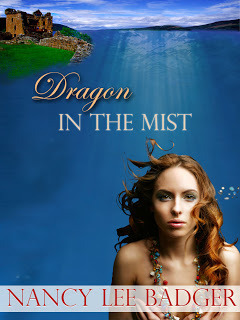

Website: http://www.nancyleebadger.comBlog: http://www.RescuingRomance.nancyleebadger.comTwitter: @NLBadgerFacebook: http://on.fb.me/v12gxG
More about Nancy's latest release:Title: SOUTHERNFRIED DRAGONAuthor: Nancy Lee BadgerGenre:Paranormal HistoricalLength: 30,000Word NovellaAmazon ASIN: B0074CX7SEBuy Link: http://amzn.to/zgv30B
Published on March 22, 2012 03:00
March 21, 2012
Guest Author Amanda Forester -- Fact or Fiction: French Knights in Medieval Scotland?
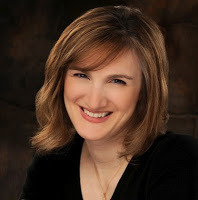 Today on History Undressed, I'm pleased to welcome Amanda Forester back for another fascinating post! And if you leave a comment you'll be entered for a chance to win a copy of her new release, TRUE HIGHLAND SPIRIT. (US & Canada Only)
Today on History Undressed, I'm pleased to welcome Amanda Forester back for another fascinating post! And if you leave a comment you'll be entered for a chance to win a copy of her new release, TRUE HIGHLAND SPIRIT. (US & Canada Only)
Factor Fiction: French Knights in MedievalScotland?
by Amanda Forester
Onething I enjoy about writing historical fiction is doing the research. As a history buff, I enjoy learning newhistorical facts. For example, I wassurprised to learn that Scotland was almost conquered by the English in1356. Okay, that's not terriblysurprising since the Scots were almost conquered by the English many timesthroughout history, but this particular time the French were to blame.
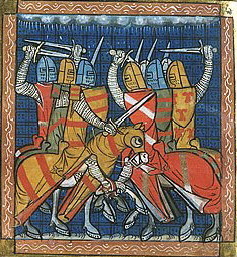 Letme set the stage. In 1346, Scotland'sKing David (the son of Robert the Bruce) invaded England but was defeated atthe Battle of Neville's Cross and taken prisoner by King Edward III. Nine years later, David was still locked inthe Tower of London while the two countries slowly negotiated the ransom tosecure his release.
Letme set the stage. In 1346, Scotland'sKing David (the son of Robert the Bruce) invaded England but was defeated atthe Battle of Neville's Cross and taken prisoner by King Edward III. Nine years later, David was still locked inthe Tower of London while the two countries slowly negotiated the ransom tosecure his release. Onthe eve of a settlement, France entered the picture with a tempting offer. The French were currently at war with England(in what was later known as the Hundred Year's War), and had no interest inseeing peace on the British Isle. So alegion of French knights sailed off to Scotland and offered 40,000 moutons ofgold if Scotland would agree to go to war with England.
In1355 the Scots and French invaded northern England. Unfortunately, they underestimated England'sreserve and at the sight of 80,000 experienced English troops, the Frenchdecided it was time to go home and left the Scots to their fate.
Nowthe Scots were in a tight spot. Theyretreated, but King Edward declared himself the King of Scotland and threatenedto invade. The Scots realized theycould not survive open warfare against the English, and so relied instead on abit of trickery. They sent the Earl ofDouglas to negotiate their surrender, and gained 10 days of a truce. During this time, the Scots retreated backinto the North, taking every scrap of food with them. When King Edward finally marched intoScotland he found it devoid of all living inhabitants. Unable to live off the land, Edward wasforced to rely on dwindling supplies. Edwardwas enraged at being deceived by Douglas and in vengeance marched intoScotland, burning and destroying everything in his wake. This was later known as Burnt Candlemas. However, Edward's wrath was short lived, ashis soldiers were nearing starvation. The English king was forced to retreat, and the Scots made the most ofharassing the hungry troops as they fled back to England.
Thiswonderful bit of history inspired my second and third books in my Highlanderseries. In TRUEHIGHLAND SPIRIT the hero is in fact a French knight. I'm sure readers will probably think I'veallowed my imagination to run wild. French knights in Scotland?Preposterous! And yet, that part of thebook is actually based on fact!
TRUEHIGHLAND SPIRIT chronicles the initial attack by the French and Scots and theaftermath. With the independence ofScotland at stake, who can save them? Myheroine of course! In my book Morrigan develops the plan to repel the Englishout of Scotland. And that, my friends,is pure fiction. This is the best partabout writing historical fiction for me - using the rich historical setting tospark the imagination and create interesting characters through whose escapadesI can live during fascinating times in history… all without giving up hotshowers or central heating! Happyreading!
Do you enjoy novels that bring the history to life in the lives of thecharacters? What is the right balancefor you between character, plot, and history lesson? Comment on the blog for a chance to win acopy of TRUE HIGHLAND SPIRIT.
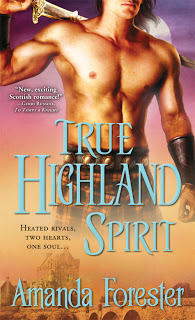 TRUE HIGHLAND SPIRITMorriganMcNab learned to survive with a sword in her hand. Taking command, she isdetermined to protect her impoverished clan, no matter the cost. When anelusive French knight offers gold to fight against England, she joins the callto arms. Sparks fly on the battlefield as a forbidden passion smolders betweenMorrigan and Sir Dragonet. Yet Sir Dragonet holds a secret that will destroythe hope for a life together, and will make them rivals on a dangerous questfor a mysterious relic. As they fight beside each other against the English,and against each other to find the treasure, their love becomes a greater forcethan either can control.
TRUE HIGHLAND SPIRITMorriganMcNab learned to survive with a sword in her hand. Taking command, she isdetermined to protect her impoverished clan, no matter the cost. When anelusive French knight offers gold to fight against England, she joins the callto arms. Sparks fly on the battlefield as a forbidden passion smolders betweenMorrigan and Sir Dragonet. Yet Sir Dragonet holds a secret that will destroythe hope for a life together, and will make them rivals on a dangerous questfor a mysterious relic. As they fight beside each other against the English,and against each other to find the treasure, their love becomes a greater forcethan either can control.VisitAmanda: website, facebook, or twitter.
Published on March 21, 2012 07:49
March 14, 2012
Guest Author Sarah Bower (Giveaway!)
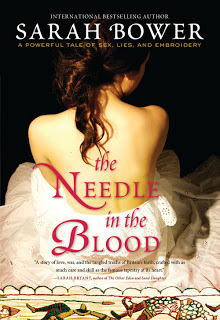 Welcome to History Undressed, Sarah Bower, author of Needle in the Blood--which I have sitting on my TBR pile, cannot wait to read it! Today she is giving us a bit of history behind the book. Leave a comment for your chance to win a copy.
Welcome to History Undressed, Sarah Bower, author of Needle in the Blood--which I have sitting on my TBR pile, cannot wait to read it! Today she is giving us a bit of history behind the book. Leave a comment for your chance to win a copy.
Thank you for inviting me on to your blog to talkabout my new novel, THE NEEDLE IN THE BLOOD. I'd like to set the book in itshistorical context by telling you something about the Bayeux Tapestry.
Given how we like to celebrate our failures in thiscountry (Dunkirk, the Charge of the Light Brigade), it isn't surprising thatthe one historical date every school child knows is 1066, the year in whichthese islands were conquered by William, Duke of Normandy, francophonedescendant of the legendary Roland/Odo/Orlando (depending on who is writingabout him) who had moved from Scandinavia to settle in northern France about ahundred years earlier.
Although the Normans were, without doubt, brutal,ruthless and destructive in the way they went about their conquest, they alsoplanned shrewdly for the long term. Despite incidents of staggering violencesuch as the Harrying of York in 1069 to 70, when farm animals as well as peoplewere slaughtered wholesale, William's main weapon was to pension off formerAnglo Saxon leaders, buying their loyalty with gifts of land, and to encouragethe Norman governors with whom he replaced them to marry native women and facilitatea blending of cultures. This is why, although we still speak of ourselves as anAnglo Saxon people, and use this concept to explain ourselves to ourselves inall kinds of ways, from our drinking habits to our economic structures, much ofour most famous heritage – our castles and cathedrals, our hereditary monarchy– is attributable to the Norman Conquest. So we remember 1066, not just as aglorious failure but also as a foundational date in the modern history ofBritain.
William may have been a tough soldier, a mercilessdisciplinarian whose wife and children all fell out with him, but he alsoabolished slavery and the death penalty in England and Wales, and he had anaffection for hares, whose killing was forbidden under his hunting statutes.The contradictions of the history inhere in the character of the Conquerorhimself.
The Bayeux Tapestry is the best known record of theConquest, and the events leading up to it which William believed justified hisclaim to the English throne after the death of Edward the Confessor withoutheirs. Its central narrative is a shameless piece of Norman propaganda,presenting William as the rightful heir, wronged and cheated by a duplicitousHarold Godwinson. Even its most familiar image, of King Harold being killed bya shot in the eye, is more symbolism than truth. The putting out of an eye wasa Norman punishment for theft. Harold probably met a much grizzlier end, butthe truth of that did not matter to the Tapestry's Norman patron so much as thesymbolic message sent out by showing him losing an eye.
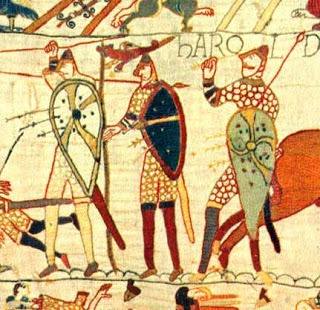
Once I began studying the Tapestry while researchingTHE NEEDLE IN THE BLOOD, however, I quickly discovered that, like the story ofthe Conquest itself, nothing is as straightforward and clear cut as it seems.Even this scene is ambiguous, because the caption, 'hic haroldus interfectusest' could refer to another Anglo Saxon soldier, shown felled by an axe, alittle to the right of the famous image of the man shot in the eye. Perhapssomebody has attempted to bear witness to the truth while still paying lipservice to the propaganda.
The Bayeux Tapestry is both utterly familiar andcompletely mysterious. Although most scholars believe Bishop Odo of Bayeux,William's half brother, to have been its patron, there is only circumstantialevidence for this, arising from the way he is portrayed in the narrative andthe fact that the Tapestry had its first showing at the dedication of BayeuxCathedral in 1077. Although it is likely the Tapestry was made in England,because England was the go-to place for embroidery in the mid-eleventh century,again, we do not know for sure. Looking at the images themselves, while themain narrative is fairly – but not entirely – straightforward, the top andbottom margins are very strange indeed. They contain images of heraldic beasts,illustrations from Aesop's Fables, violence far more graphic than anythingfound in the main narrative and several overtly sexual scenes. Nothing in themargins seems to bear a direct relation to the main narrative; clearly there isa conversation going on here, perhaps between the Norman patron and his Englishembroiderers. Or perhaps there is no conversation at all, but the 'official'Tapestry on one level and coded messages of resistance on another.
I was attracted by the idea of the Tapestry as anexpression of tension between the patron and the conquered embroiderers,between the celibate bishop and a workshop full of women, and also by anothermysterious, and much discussed, image, that of Aelfgyva and the priest.
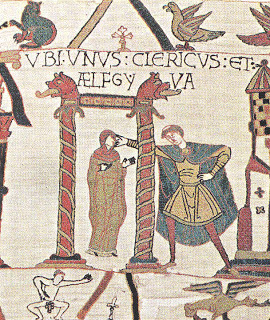
Again, nobody has been able to identify these twofigures for certain, and you can see immediately that the priest's apparent actof violence towards Aelfgyva may not be all it seems. Look at the way in whichthe naked figure in the lower margin mirrors his action. Could it be that thesetwo are lovers rather than enemies?
This image, and its ambiguity, are central to THENEEDLE IN THE BLOOD, which is both a love story and a story about how thetrauma of conquest affects conquerors as well as conquered. I hope my readerslove Odo and Gytha as much as I do, but I also hope the novel sheds some lighton how England became England and how, as we so enjoy doing, we managed to makea triumph out of what remains our biggest disaster to date.
If you would like to know more, please visit THENEEDLE IN THE BLOOD Facebook page where you will find a bibliography of thetexts I used in my research, links to other blogs – oh, and evidence of therole Batman played in the Norman Conquest!
*~*~*~*
Sarah Bower is a novelist and short story writer. Her first novel, The Needle in the Blood, was Susan Hill's Book of the Year 2007. Her short stories have appeared in magazines including QWF, Buzzwords and The Yellow Room. She completed an MA in Creative Writing at the University of East Anglia in 2002. She teaches creative writing at UEA and for the Open University. She also works as a mentor and manuscript reader for leading literary consultancies. Visit her at http://www.sarahbower.co.uk/
Published on March 14, 2012 03:00
March 13, 2012
Video of the Week: Uptown Downstairs Abbey
For those Downtown Abbey fans, a funny video spoof from the BBC--Uptown Downstairs Abbey! Lots of familiar and fun faces. Can you name them?

Published on March 13, 2012 06:00
March 7, 2012
The Last of the Big Boys by Alethea Williams
Today on History Undressed, I'd like to introduce you to a new guest author, Alethea Williams! Ms. Williams is taking us back to the 1950's. Thanks for being here with us today!
The Last of the 'Big Boys'From the series "Southwest Wyoming: A Tough Place to Live," a new feature on www.actuallyalethea.blogspot.com.
(Originally printed in the HistoricalIssue of the Green River Star, March 19,1998.)
I didn't want to go downin that hole. I wanted to see thesunshine.
– C.D. "Don" Englert
Fresh out ofhigh school in Superior, Wyoming in the spring of 1950, C.D. "Don"Englert had the choice of joining the Union Pacific Railroad or the coalmine. He picked the railroad, startingon the extra gang at Thayer Junction where the Superiorroad joined Highway 30.
The extragang was a labor intensive crew of 180 men that comprised three gangs inone. The first gang raised the track,the second put in the ties, and the third ballasted and tamped.
Thefour-hole, bolted track was raised and leveled by eye, with a "rabbit" peepsiteon the track and a long white spotboard with a black line. But according to Don, raising track without benefitof electronics still "made a good looking track."
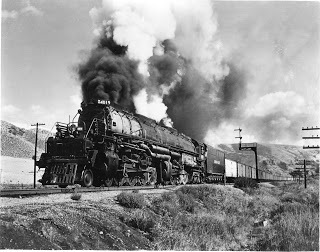
UnionPacific Railroad's 4-8-8-4 "Big Boy" class steam locomotive #4019 and stringof PFE cars in Echo Canyon, Utah. First of this type locomotive built in 1941for freight service.
Photo Courtesy Sweetwater County HistoricalMuseum While other U.P. divisions were rapidlyconverting to diesel engines, the Wyoming Division continued to run the hugeblack steam engines called Big Boys in order to best utilize the company'scoal. Men hitched rides to work onMonday on milk trains, local trains that hauled the mail and were willing tostop anywhere free of cost to company employees.
During theweek, maintenance-of-way workers lived in outfit cars, 10 or more men in eachboxcar converted with windows, a door, a stove and bunks lining the walls. One or two men in the bunk car kept coal andwater buckets filled.
Breakfast anddinner were served in the commissary car, but chow lines formed at the worksite for lunches of huge 20-gallon "hot pots" of soup with sandwiches. While the crew was working, one man wasdesignated the water boy. With hiswooden barrels, a bucket and a dipper, he would start with the head man andcome down through the line offering each a drink from the dipper.
Unable tocompletely fill the ranks for the grueling summer work, the railroad recruitedon the skid rows of 25th Street in Ogden, Utah; Larimer Street in Denver;and in Cheyenne.
Don recallswith amusement that the "winos" worked only until they got their paychecks of$1.12 an hour and that today there would be few who would be willing to shareliving quarters or the same water dipper with them.
With gradesand curves the enemies of railroad efficiency and heavy Big Boys hammering therail, there was still work for an ambitious young man after the extra gang wasdisbanded for the winter.
 Don took a job as a section man, married and lived withhis bride in a two-room boxcar with no running water. He passed the foreman's exam in 1952, workingthe Wyoming Division between Ogden and Cheyenne relieving otherforemen for vacations.
Don took a job as a section man, married and lived withhis bride in a two-room boxcar with no running water. He passed the foreman's exam in 1952, workingthe Wyoming Division between Ogden and Cheyenne relieving otherforemen for vacations.
Promotedagain to rail inspector, Don rode a little motorcar with no windshield, lookingfor broken rail, bad ties and deep holes in the track. Before the days of insulated coveralls, arail inspector wore layers of clothing to ward off the bitter cold and wrappedhis feet in a piece of sheepskin. Putt-putting down the track against the Wyoming wind, it often took much longer thaneight hours to cover the 30 miles a day, stopping to inspect all the switchesand look for loose bolts. When he cameup on a curve, he set the 500-pound motorcar off by its handles and inspectedthe curve on foot with a magnifying Sands mirror, looking under the rail forcracks, head and web separation and broken rail.
The lineupwas put out morning and noon to alert workers on the track to trainschedules. Every two hours, Don wouldstop at a telephone situated at passing tracks or use a field phone with a longpole that connected to the telegraph lines to call the dispatcher. Wiley Shaver was the dispatcher in Green River and if he gave a time on a train, "you betterbelieve it" according to Don. Or a braveman could just "look for the smoke" of the steam engines; not an option withthe coming of the diesels!
Telegraphpoles no longer line the track. The coalchutes are gone. But those who workedthe rails remember when the Big Boys passed and men stood with shirt collarsclutched and eyes closed against flying cinders as the boiler workeduphill. Still yet at Creston Hill,Tipton Hill and in to Rock Springs, the carbon residue from steam enginesdrifts deep in the ditches alongside welded tracks built mainly now withmachines instead of manpower.
*~*~*~*
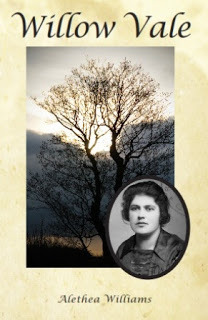
Theauthor would like to thank Eliza Knight for the opportunity to guest blog on History Undressed. Alethea Williams has recently released thehistorical novel, Willow Vale. You can read more about the book and its southwestWyomingorigins, as well as Alethea's journey as a writer, on her blog at http://actuallyalethea.blogspot.com/.

The Last of the 'Big Boys'From the series "Southwest Wyoming: A Tough Place to Live," a new feature on www.actuallyalethea.blogspot.com.
(Originally printed in the HistoricalIssue of the Green River Star, March 19,1998.)
I didn't want to go downin that hole. I wanted to see thesunshine.
– C.D. "Don" Englert
Fresh out ofhigh school in Superior, Wyoming in the spring of 1950, C.D. "Don"Englert had the choice of joining the Union Pacific Railroad or the coalmine. He picked the railroad, startingon the extra gang at Thayer Junction where the Superiorroad joined Highway 30.
The extragang was a labor intensive crew of 180 men that comprised three gangs inone. The first gang raised the track,the second put in the ties, and the third ballasted and tamped.
Thefour-hole, bolted track was raised and leveled by eye, with a "rabbit" peepsiteon the track and a long white spotboard with a black line. But according to Don, raising track without benefitof electronics still "made a good looking track."

UnionPacific Railroad's 4-8-8-4 "Big Boy" class steam locomotive #4019 and stringof PFE cars in Echo Canyon, Utah. First of this type locomotive built in 1941for freight service.
Photo Courtesy Sweetwater County HistoricalMuseum While other U.P. divisions were rapidlyconverting to diesel engines, the Wyoming Division continued to run the hugeblack steam engines called Big Boys in order to best utilize the company'scoal. Men hitched rides to work onMonday on milk trains, local trains that hauled the mail and were willing tostop anywhere free of cost to company employees.
During theweek, maintenance-of-way workers lived in outfit cars, 10 or more men in eachboxcar converted with windows, a door, a stove and bunks lining the walls. One or two men in the bunk car kept coal andwater buckets filled.
Breakfast anddinner were served in the commissary car, but chow lines formed at the worksite for lunches of huge 20-gallon "hot pots" of soup with sandwiches. While the crew was working, one man wasdesignated the water boy. With hiswooden barrels, a bucket and a dipper, he would start with the head man andcome down through the line offering each a drink from the dipper.
Unable tocompletely fill the ranks for the grueling summer work, the railroad recruitedon the skid rows of 25th Street in Ogden, Utah; Larimer Street in Denver;and in Cheyenne.
Don recallswith amusement that the "winos" worked only until they got their paychecks of$1.12 an hour and that today there would be few who would be willing to shareliving quarters or the same water dipper with them.
With gradesand curves the enemies of railroad efficiency and heavy Big Boys hammering therail, there was still work for an ambitious young man after the extra gang wasdisbanded for the winter.
 Don took a job as a section man, married and lived withhis bride in a two-room boxcar with no running water. He passed the foreman's exam in 1952, workingthe Wyoming Division between Ogden and Cheyenne relieving otherforemen for vacations.
Don took a job as a section man, married and lived withhis bride in a two-room boxcar with no running water. He passed the foreman's exam in 1952, workingthe Wyoming Division between Ogden and Cheyenne relieving otherforemen for vacations. Promotedagain to rail inspector, Don rode a little motorcar with no windshield, lookingfor broken rail, bad ties and deep holes in the track. Before the days of insulated coveralls, arail inspector wore layers of clothing to ward off the bitter cold and wrappedhis feet in a piece of sheepskin. Putt-putting down the track against the Wyoming wind, it often took much longer thaneight hours to cover the 30 miles a day, stopping to inspect all the switchesand look for loose bolts. When he cameup on a curve, he set the 500-pound motorcar off by its handles and inspectedthe curve on foot with a magnifying Sands mirror, looking under the rail forcracks, head and web separation and broken rail.
The lineupwas put out morning and noon to alert workers on the track to trainschedules. Every two hours, Don wouldstop at a telephone situated at passing tracks or use a field phone with a longpole that connected to the telegraph lines to call the dispatcher. Wiley Shaver was the dispatcher in Green River and if he gave a time on a train, "you betterbelieve it" according to Don. Or a braveman could just "look for the smoke" of the steam engines; not an option withthe coming of the diesels!
Telegraphpoles no longer line the track. The coalchutes are gone. But those who workedthe rails remember when the Big Boys passed and men stood with shirt collarsclutched and eyes closed against flying cinders as the boiler workeduphill. Still yet at Creston Hill,Tipton Hill and in to Rock Springs, the carbon residue from steam enginesdrifts deep in the ditches alongside welded tracks built mainly now withmachines instead of manpower.
*~*~*~*

Theauthor would like to thank Eliza Knight for the opportunity to guest blog on History Undressed. Alethea Williams has recently released thehistorical novel, Willow Vale. You can read more about the book and its southwestWyomingorigins, as well as Alethea's journey as a writer, on her blog at http://actuallyalethea.blogspot.com/.
Published on March 07, 2012 03:00
March 6, 2012
Video of the Week: Mr. Darcy Discos
Published on March 06, 2012 10:04
March 5, 2012
Today on Nook -- HIS LAST DUCHESS for only $1.99! (Giveaway!)
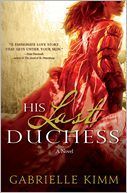 Just received word from Sourcebooks that HIS LAST DUCHESS is Barnes and Noble's Nook Daily Find!
Just received word from Sourcebooks that HIS LAST DUCHESS is Barnes and Noble's Nook Daily Find!Click here to enjoy today for only $1.99
That's my last duchess painted on the wall...
Seduced by the hot sun and blinding passions of Renaissance Italy, sixteen-year-old Lucrezia de' Medici sees a gilded life stretching ahead. Her wealthy new husband handpicked her to be his bride, and his great castle in Ferrara will be her playground. But Alfonso d'Este, Duke of Ferrara quickly proves to be just as dangerous and mysterious as he is dark and handsome, and the stone walls of the castle seem to trap Lucrezia like a prison.
Only the duke's lover Francesca seems able to tame his increasing fury, as his desperate need to produce an heir drives him deep into precarious obsession. With her head full of heartbroken dreams, Lucrezia flees from him down a dangerous path that may cost her everything.
Step into the elegant world of the Robert Browning poem "My Last Duchess," as imagined by Gabrielle Kimm, where she brings to life the passions and people of sixteenth-century Tuscany and Ferrara. It is a chilling story of forbidden love and dark decadence that will haunt you.
GIVEAWAY!!!! Leave a comment and one winner will receive a galley copy of Gabrielle Kimm's new book, THE COURTESAN'S LOVER! (US & Canada only).
Published on March 05, 2012 12:32
March 4, 2012
Feature: The Famous Daily
 Each Calendar Day Of The Year Has History Attached To It
Each Calendar Day Of The Year Has History Attached To ItWhen you wake up on a rainy Tuesday in March - you may feel like you are going through the motions of just another day of the year. But something special could happen on any day - and the more we realize that - the more we can take advantage of each day. At the Famous Daily , you can visit any Calendar day of the year to see what makes that day special. It can be quite fascinating to see all of the important and historical events that occurred on a particular day. You can discover the Famous People which were born today, and you can see a Famous Quote that was said on this day in history.
And while we all love holidays, they only come around every so often. However, somewhere in the world, each day is a holiday. The Famous Daily will highlight what holiday is being celebrated today in the world.
Lastly, different history is of interest to different people. So in addition to general history, the Famous Daily categorizes today's history by Business, Entertainment, Geography, and Sports. This allows users to quickly see what important history happened today in the area that they care most about.
So the next time you wake up on the wrong side of the bed, or get down and think that today isn't important - realize that it is. Today in history, amazing things happened, and by embracing yourself with and understanding of those amazing things, you are much less likely to let the day pass without finding a way to make it important and special.
And if you enjoy the Famous Daily, you can subscribe for free and get it delivered to your email each morning. Evan BrittonFounder of the Famous Dailywww.famousdaily.com
Published on March 04, 2012 03:00
February 29, 2012
The Magic of Vienna by Lynn Crain
I'd like to welcome guest author, Lynn Crain, to History Undressed! She's written a lovely post today for us on Vienna. I hope you enjoy it as much as I did! Leave a comment for your chance to win a $20 Amazon GiftCard and a copy of Lynn's new tale, A LOVER FOR RACHEL.
The Magic of Viennaby Lynn Crain
In May of this year, my husband and I said goodbye to our house, family and everything I have ever known to run away from home to Vienna, Austria. The DH had received a job offer that we couldn't refuse, so he took it. In short order, much faster than we expected, we were off on the adventure of a lifetime. Our children were grown and this was some needed 'us' time was how the DH presented it. Needless to say, I wasn't happy about moving at first but I understood it. I knew this was a fantastic opportunity to live somewhere different and visit all those places I thought about when I was a kid, first in rural Ohio then Nevada. I knew it would be great for my husband's career.
One thing I want to say to those who envy me, be careful what you wish for but that would be a lie because it's all a matter of perspective. When we are young, everything looks cool because it's different from what we have or where we are. When we're older, we look at our lives in a new light, wondering what's the economic impact. My thought process went immediately to my writing and how I could make it better. The historical aspect of this city boggles my mind. The whole town oozes history in more ways than I can count. Let's take a look at the illustrious history, both good and bad, that make up Vienna. I will only touch upon those areas that I have experienced myself as it is much too much to get into one tiny blog post. At the end, I will give a list of websites that will give you even more detail.
Vienna's history started when the Romans decided to place a military camp in the centre of the present day city. This was during the first century and there are various places today where that occupation can still be seen. Places like Michaelerplatz and Stubentor still hold Roman wall remnants. For those willing to go further afield, then a trip to Carnuntum approximately 25 kilometers outside the city is the place to be. There one can experience a Roman amphitheater that rivals the Coliseum. Just recently, the biggest gladiatorial school was located within that area. Here are a few pictures of our day trip to the ruins. We plan to go back many, many times.
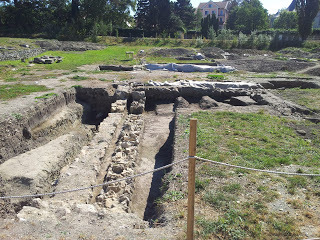 The Ruins at Carnuntum
The Ruins at Carnuntum
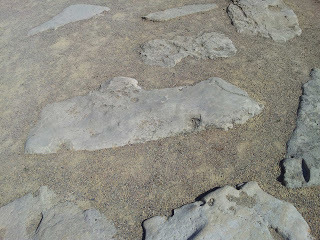 The Ancient Cobbles of a Roman Road
The Ancient Cobbles of a Roman Road
The early medieval streets and houses followed the former Roman walls and it is thought that at least some of the ancient fortifications were used by the people who settled the area. The first documented mention of Vienna is from 881 when a battle called apud Weniam was fought against the Hungarians. It isn't clear whether it was the city itself or the river in the passage. Coins from the 6th century have been found near the city center, which may indicate an area for trade. During that time the Lombards controlled the area followed by the Slavs and Avars. There is a mention of a battle against the Magyars in Wenia in 881 that is thought to be another mention of Vienna. The city proper didn't start to develop more towards the Middle Ages.
In 976, Margraviate of Ostarrîchi was given to the Babenburg family or basically, a woman was married off to Leopold I who then gained control of the area known as the Eastern March. He received this as a reward for his fidelity to Otto II during the Bavarian rising of 976 and during his time extended it even more at the expense of the Hungarians. The word Margraviate is a heredity title give to those noblemen and women responsible for the border provinces of a kingdom. The history of this group is intense and convoluted and even after I've read it five times, it's hard to keep straight.
An important time of note is around the Third Crusade. King Richard the Lionheart was discovered by Duke Leopold V, two days before Christmas 1192 in Erdberg, near Vienna. Duke Leopold asked an enormous ransom at the time of 50,000 Silver Marks. With this money, a mint was created and the city constructed walls around the area. Stubentor, which I mentioned above, is one area that those walls can be seen as some parts were built upon the even older Roman walls. It's interesting to mention that today, I can ride a train to Erdberg as it is a major stop on one of the train lines.
The time of the Hapsburgs started in 1278 with Rudolph the first and didn't end until Emperor Franz Joseph the first on his death in 1916, whose 68-year reign was one of Austria's longest. Franz Joseph shaped the image of Austrian imperial rule and under him Vienna became one of Europe's most important metropolises of its day. He made the city the center of a multi-national state that extended from Hungary to northern Italy and deep into southern Europe. Everything I see out my flat window has his touch stamped on it along with the history that made his time possible. My building was built during the height of his rule in 1868.
During Franz Joseph's reign, Johann Strauss became the King of Waltz and Sigmund Freud founded the psychoanalytical school of psychology. Around 1900, Art Nouveau peaked with such artists as Gustav Klimt and Egon Schiele as well as the famed architects of Otto Wagner and Adolf Loos. The Ringstrasse was built and museums dotted the landscape. But Austria was also a ticking time bomb with ethnic tensions, making the monarchy an accident waiting to happen. The assassination of the Archduke Franz Ferdinand in June 14 in Sarajevo marked the beginning of World War I.
Standing next to the desk where Emperor Franz Joseph signed the declaration of war was an eerie feeling to say the least. It happened at his hunting lodge known as Kaiservilla, where many events of his life had played out: falling in love, children, the death of his beloved Sisi. It is near Salzburg in a little town called Bad Ischl and is well worth visiting if you ever have a chance. Here are a few pictures then we'll return to Vienna proper.
 Mountains behind Kaiservilla
Mountains behind Kaiservilla
 The back of Kaiservilla
The back of Kaiservilla
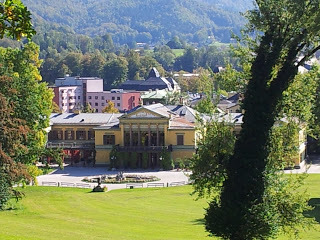 The whole of Kaiservilla
The whole of Kaiservilla
 Under the trees at the top of the ridge behind Kaiservilla
Under the trees at the top of the ridge behind Kaiservilla
In 1916 during the war, Franz Joseph dies. In 1918 after the war was over, the first Republic of Austria was established ending the 640-year-old rule of the Habsburg dynasty. It was unfortunate that the young republic suffered massive inflation, unemployment and near economic collapse. In 1933, the weak coalition government between the Christian-Social and the Social-Democratic parties gave way to Engelbert Dollfuss becoming Chancellor in 1932 of a right-wing government. In 1934, he declared martial law to protect Austria from Hitler but he was killed that same year in July thus paving the way for Germany to take over the country.
Not much is said by the Austrians about their part in World War II but there are quite a few memorials and museums that bare witness to what happened here and elsewhere in Europe. It took Austria ten years to get back to where they were in 1937. In May 1955, they declared permanent neutrality and became a nerve center between East and West during the time of the Iron Curtain. Austria has been granting asylum to refugees since 1956 and is the host country to many international organizations, such as the UN and the CTBTO, which my husband work for. In 1995, Austria became a member of the European Union and remains so today.
I live across the street from the Palace Belvedere and the Palace Schwartenberg. Belevedere was once a summer home for the Habsburgs and in particular Prince Eugene. I'm still trying to understand where Palace Schwartenberg figures into all of this but I do know there's a house on the grounds for rent. We're actually thinking about checking it out as we love the area. :-) Now the street I live on is named after the Prince and is called Prince Eugen Strasse. That's just the start of everything: there's the Hofburg, Schonnbrunn, Carnuntum which is the Roman ruin I mentioned above and deserves more than a day, Stephensplatz, Karlsplatz and more churches like them that you wouldn't believe. Recently, I saw a Templar church they've uncovered under Stephensplatz. I've noted that early man lived here as did the Celts. Just reading Wikipedia to get the overview can be overwhelming...but...think of the opportunity for historicals, for contemporaries or for anything a writer can think up. Here's a few more pictures to show you what I mean.
While this is the view out my office window, I should make note that not only do I see the guard quarters for Belvedere as well as part of the grounds, but history. If I look a little harder, I'm sure I can see the Emperors and Empresses of a day gone by, of kings and queens and their children as they play on the grounds surrounding the palaces.
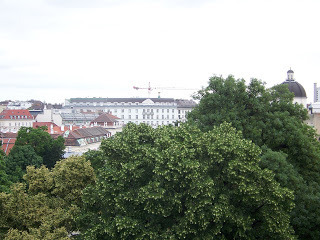 Out My Office Window
Out My Office Window
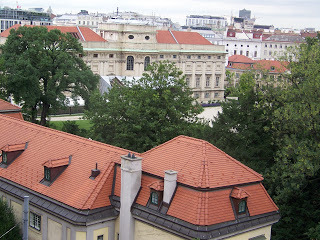 Palace Schwartzenberg
Palace Schwartzenberg
Here's some pictures of one of my favorite places to visit, Schönbrunn, the palace to rival Versailles.
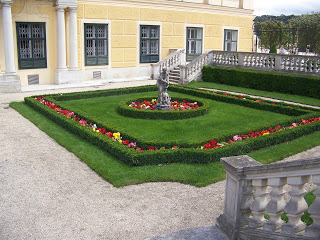 One of the many gardens
One of the many gardens
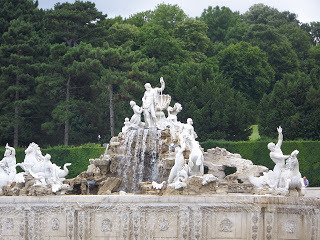 The Neptune Fountain
The Neptune Fountain
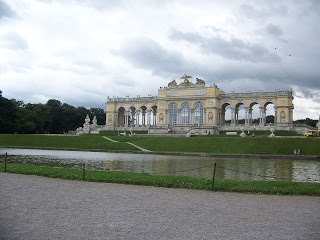 The summerhouse
The summerhouse
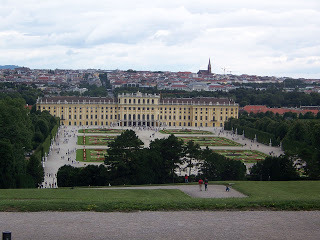 Rear view and gardens of Schönbrunn
Rear view and gardens of Schönbrunn
Then there's the museums. Here's some of my favorites.
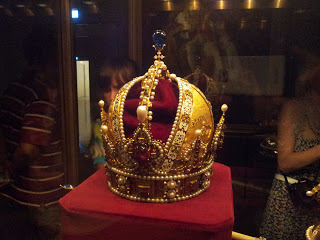 The Crown Jewels
The Crown Jewels
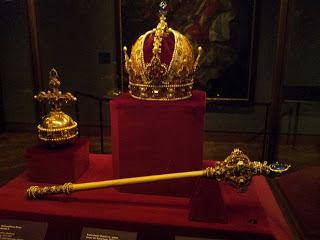 The Complete Crown Jewels
The Complete Crown Jewels
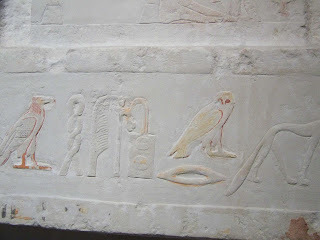 The Egyptian Glyphs
The Egyptian Glyphs
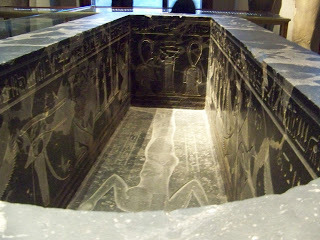 The Sarcophagus
The Sarcophagus
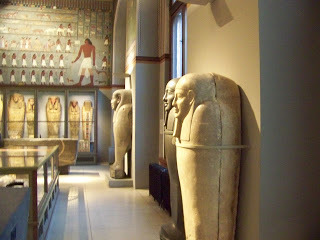 More Egyptian Artifacts
More Egyptian Artifacts
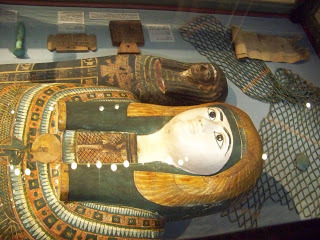 Even more!
Even more!
These pictures don't even begin to do the place justice. I have only touched on the bare minimum of the history I see and feel and touch daily. Sometimes the senses can be overwhelmed by it as I try to picture what it used to be like. I promise to bring you more and more of the historical perspective on living in Vienna, Austria. Yes, this place has plenty for a writer to learn, plenty for me to figure out and understand. Even though the perspective has changed a lot from when I was younger, living the fairy tale can and does have its own perks.
For more about Austria, visit my blog, A Writer In Vienna, as I try to give all my impressions for living in a foreign country. Some days I revisit history, others I might be taking in a big ride or even a wild ride as my husband and I take to the streets driving here for the first time. Life is always interesting! Don't hesitate to drop me a line if you need any information concerning the area. If you're going to be in my neck of the woods, please let me know. I just love visitors!
You can find me at twitter (oddlynn3) or Facebook (oddlynn3) as well as my website, and regular blog. Please excuse the dust on both the website and blog as they are currently being revamped. Be ready for their unveiling in Spring 2012. Look for my new short, A Lover for Rachel, from Shooting Star Books for only $0.99 at all ebook outlets. I've included the cover art...who doesn't love a Jimmy cover?

See you all next time!
Lynn
Here's a list to get you started with Vienna. It is by no means inclusive as there are many, many interesting books and takes on life here and how it all began. These are just a few that I used while creating this blog posting.
http://en.wikipedia.org/wiki/Margraviatehttp://en.wikipedia.org/wiki/Ostarr%C3%AEchi
http://en.wikipedia.org/wiki/Babenberg
http://en.wikipedia.org/wiki/House_of_Habsburg
http://www.nhm-wien.ac.at/
http://www.viennaaustria.co.uk/
http://www.jewishvirtuallibrary.org/jsource/vjw/Vienna.html
http://en.wikipedia.org/wiki/Innere_Stadt
http://en.wikipedia.org/wiki/Ferdinand_IV,_Grand_Duke_of_Tuscany
http://en.wikipedia.org/wiki/House_of_Habsburg
http://www.khm.at/
http://www.austria.info/us/about-austria/history-1140682.html
http://en.wikipedia.org/wiki/Vienna
http://en.wikipedia.org/wiki/History_of_Vienna
The Magic of Viennaby Lynn Crain
In May of this year, my husband and I said goodbye to our house, family and everything I have ever known to run away from home to Vienna, Austria. The DH had received a job offer that we couldn't refuse, so he took it. In short order, much faster than we expected, we were off on the adventure of a lifetime. Our children were grown and this was some needed 'us' time was how the DH presented it. Needless to say, I wasn't happy about moving at first but I understood it. I knew this was a fantastic opportunity to live somewhere different and visit all those places I thought about when I was a kid, first in rural Ohio then Nevada. I knew it would be great for my husband's career.
One thing I want to say to those who envy me, be careful what you wish for but that would be a lie because it's all a matter of perspective. When we are young, everything looks cool because it's different from what we have or where we are. When we're older, we look at our lives in a new light, wondering what's the economic impact. My thought process went immediately to my writing and how I could make it better. The historical aspect of this city boggles my mind. The whole town oozes history in more ways than I can count. Let's take a look at the illustrious history, both good and bad, that make up Vienna. I will only touch upon those areas that I have experienced myself as it is much too much to get into one tiny blog post. At the end, I will give a list of websites that will give you even more detail.
Vienna's history started when the Romans decided to place a military camp in the centre of the present day city. This was during the first century and there are various places today where that occupation can still be seen. Places like Michaelerplatz and Stubentor still hold Roman wall remnants. For those willing to go further afield, then a trip to Carnuntum approximately 25 kilometers outside the city is the place to be. There one can experience a Roman amphitheater that rivals the Coliseum. Just recently, the biggest gladiatorial school was located within that area. Here are a few pictures of our day trip to the ruins. We plan to go back many, many times.
 The Ruins at Carnuntum
The Ruins at Carnuntum The Ancient Cobbles of a Roman Road
The Ancient Cobbles of a Roman RoadThe early medieval streets and houses followed the former Roman walls and it is thought that at least some of the ancient fortifications were used by the people who settled the area. The first documented mention of Vienna is from 881 when a battle called apud Weniam was fought against the Hungarians. It isn't clear whether it was the city itself or the river in the passage. Coins from the 6th century have been found near the city center, which may indicate an area for trade. During that time the Lombards controlled the area followed by the Slavs and Avars. There is a mention of a battle against the Magyars in Wenia in 881 that is thought to be another mention of Vienna. The city proper didn't start to develop more towards the Middle Ages.
In 976, Margraviate of Ostarrîchi was given to the Babenburg family or basically, a woman was married off to Leopold I who then gained control of the area known as the Eastern March. He received this as a reward for his fidelity to Otto II during the Bavarian rising of 976 and during his time extended it even more at the expense of the Hungarians. The word Margraviate is a heredity title give to those noblemen and women responsible for the border provinces of a kingdom. The history of this group is intense and convoluted and even after I've read it five times, it's hard to keep straight.
An important time of note is around the Third Crusade. King Richard the Lionheart was discovered by Duke Leopold V, two days before Christmas 1192 in Erdberg, near Vienna. Duke Leopold asked an enormous ransom at the time of 50,000 Silver Marks. With this money, a mint was created and the city constructed walls around the area. Stubentor, which I mentioned above, is one area that those walls can be seen as some parts were built upon the even older Roman walls. It's interesting to mention that today, I can ride a train to Erdberg as it is a major stop on one of the train lines.
The time of the Hapsburgs started in 1278 with Rudolph the first and didn't end until Emperor Franz Joseph the first on his death in 1916, whose 68-year reign was one of Austria's longest. Franz Joseph shaped the image of Austrian imperial rule and under him Vienna became one of Europe's most important metropolises of its day. He made the city the center of a multi-national state that extended from Hungary to northern Italy and deep into southern Europe. Everything I see out my flat window has his touch stamped on it along with the history that made his time possible. My building was built during the height of his rule in 1868.
During Franz Joseph's reign, Johann Strauss became the King of Waltz and Sigmund Freud founded the psychoanalytical school of psychology. Around 1900, Art Nouveau peaked with such artists as Gustav Klimt and Egon Schiele as well as the famed architects of Otto Wagner and Adolf Loos. The Ringstrasse was built and museums dotted the landscape. But Austria was also a ticking time bomb with ethnic tensions, making the monarchy an accident waiting to happen. The assassination of the Archduke Franz Ferdinand in June 14 in Sarajevo marked the beginning of World War I.
Standing next to the desk where Emperor Franz Joseph signed the declaration of war was an eerie feeling to say the least. It happened at his hunting lodge known as Kaiservilla, where many events of his life had played out: falling in love, children, the death of his beloved Sisi. It is near Salzburg in a little town called Bad Ischl and is well worth visiting if you ever have a chance. Here are a few pictures then we'll return to Vienna proper.
 Mountains behind Kaiservilla
Mountains behind Kaiservilla The back of Kaiservilla
The back of Kaiservilla The whole of Kaiservilla
The whole of Kaiservilla Under the trees at the top of the ridge behind Kaiservilla
Under the trees at the top of the ridge behind KaiservillaIn 1916 during the war, Franz Joseph dies. In 1918 after the war was over, the first Republic of Austria was established ending the 640-year-old rule of the Habsburg dynasty. It was unfortunate that the young republic suffered massive inflation, unemployment and near economic collapse. In 1933, the weak coalition government between the Christian-Social and the Social-Democratic parties gave way to Engelbert Dollfuss becoming Chancellor in 1932 of a right-wing government. In 1934, he declared martial law to protect Austria from Hitler but he was killed that same year in July thus paving the way for Germany to take over the country.
Not much is said by the Austrians about their part in World War II but there are quite a few memorials and museums that bare witness to what happened here and elsewhere in Europe. It took Austria ten years to get back to where they were in 1937. In May 1955, they declared permanent neutrality and became a nerve center between East and West during the time of the Iron Curtain. Austria has been granting asylum to refugees since 1956 and is the host country to many international organizations, such as the UN and the CTBTO, which my husband work for. In 1995, Austria became a member of the European Union and remains so today.
I live across the street from the Palace Belvedere and the Palace Schwartenberg. Belevedere was once a summer home for the Habsburgs and in particular Prince Eugene. I'm still trying to understand where Palace Schwartenberg figures into all of this but I do know there's a house on the grounds for rent. We're actually thinking about checking it out as we love the area. :-) Now the street I live on is named after the Prince and is called Prince Eugen Strasse. That's just the start of everything: there's the Hofburg, Schonnbrunn, Carnuntum which is the Roman ruin I mentioned above and deserves more than a day, Stephensplatz, Karlsplatz and more churches like them that you wouldn't believe. Recently, I saw a Templar church they've uncovered under Stephensplatz. I've noted that early man lived here as did the Celts. Just reading Wikipedia to get the overview can be overwhelming...but...think of the opportunity for historicals, for contemporaries or for anything a writer can think up. Here's a few more pictures to show you what I mean.
While this is the view out my office window, I should make note that not only do I see the guard quarters for Belvedere as well as part of the grounds, but history. If I look a little harder, I'm sure I can see the Emperors and Empresses of a day gone by, of kings and queens and their children as they play on the grounds surrounding the palaces.
 Out My Office Window
Out My Office Window Palace Schwartzenberg
Palace SchwartzenbergHere's some pictures of one of my favorite places to visit, Schönbrunn, the palace to rival Versailles.
 One of the many gardens
One of the many gardens The Neptune Fountain
The Neptune Fountain The summerhouse
The summerhouse Rear view and gardens of Schönbrunn
Rear view and gardens of SchönbrunnThen there's the museums. Here's some of my favorites.
 The Crown Jewels
The Crown Jewels The Complete Crown Jewels
The Complete Crown Jewels The Egyptian Glyphs
The Egyptian Glyphs The Sarcophagus
The Sarcophagus More Egyptian Artifacts
More Egyptian Artifacts Even more!
Even more!These pictures don't even begin to do the place justice. I have only touched on the bare minimum of the history I see and feel and touch daily. Sometimes the senses can be overwhelmed by it as I try to picture what it used to be like. I promise to bring you more and more of the historical perspective on living in Vienna, Austria. Yes, this place has plenty for a writer to learn, plenty for me to figure out and understand. Even though the perspective has changed a lot from when I was younger, living the fairy tale can and does have its own perks.
For more about Austria, visit my blog, A Writer In Vienna, as I try to give all my impressions for living in a foreign country. Some days I revisit history, others I might be taking in a big ride or even a wild ride as my husband and I take to the streets driving here for the first time. Life is always interesting! Don't hesitate to drop me a line if you need any information concerning the area. If you're going to be in my neck of the woods, please let me know. I just love visitors!
You can find me at twitter (oddlynn3) or Facebook (oddlynn3) as well as my website, and regular blog. Please excuse the dust on both the website and blog as they are currently being revamped. Be ready for their unveiling in Spring 2012. Look for my new short, A Lover for Rachel, from Shooting Star Books for only $0.99 at all ebook outlets. I've included the cover art...who doesn't love a Jimmy cover?

See you all next time!
Lynn
Here's a list to get you started with Vienna. It is by no means inclusive as there are many, many interesting books and takes on life here and how it all began. These are just a few that I used while creating this blog posting.
http://en.wikipedia.org/wiki/Margraviatehttp://en.wikipedia.org/wiki/Ostarr%C3%AEchi
http://en.wikipedia.org/wiki/Babenberg
http://en.wikipedia.org/wiki/House_of_Habsburg
http://www.nhm-wien.ac.at/
http://www.viennaaustria.co.uk/
http://www.jewishvirtuallibrary.org/jsource/vjw/Vienna.html
http://en.wikipedia.org/wiki/Innere_Stadt
http://en.wikipedia.org/wiki/Ferdinand_IV,_Grand_Duke_of_Tuscany
http://en.wikipedia.org/wiki/House_of_Habsburg
http://www.khm.at/
http://www.austria.info/us/about-austria/history-1140682.html
http://en.wikipedia.org/wiki/Vienna
http://en.wikipedia.org/wiki/History_of_Vienna
Published on February 29, 2012 05:25
February 28, 2012
Video of the Week: A Medieval Castle in the USA
A medieval castle in the USA, built as if it were the 13th century--the Ozark Medieval Fortress! This is on my list of places to visit now and in 20 years when its completed!! Have you been there? I see that they have delayed opening to tourists in 2012 for financial reasons... I hope that they receive enough funding to continue, because I would be thrilled to visit.
Here's the weblink: http://ozarkmedievalfortress.com/
Here is the first video...
And a second one...

Here's the weblink: http://ozarkmedievalfortress.com/
Here is the first video...
And a second one...
Published on February 28, 2012 06:00



